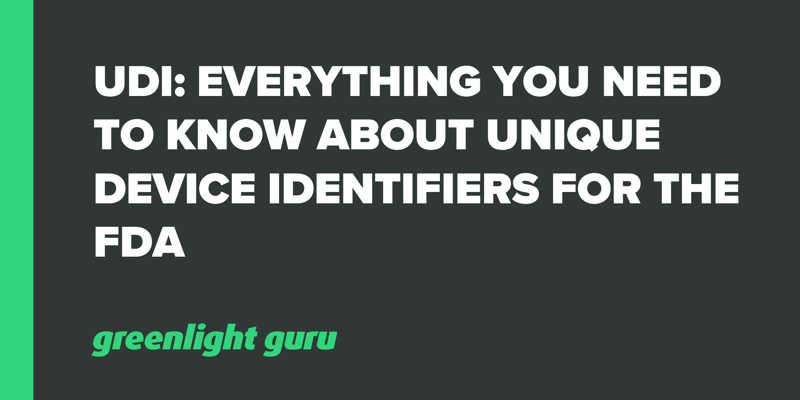UDI: Everything You Need to Know About Unique Device Identifiers for the FDA

Every aspect of the medical device industry needs to be built on the highest standards for quality and safety. While it’s never an outcome anyone wants to think about, there is great importance in planning for the worst.
When dangerous scenarios like device malfunction, adverse events, and even product recall occur, regulatory bodies want to make sure proper action is taken by the manufacturer to address the issue and prevent recurrence.
That's exactly what the FDA has done with its considerable efforts to establish the Unique Device Identifier (UDI) System.
What exactly is UDI? What are the UDI requirements from the FDA? What do US manufacturers need to know about the current state of the system and how to leverage it? Keep reading to find out everything you need to know about UDI.
WANT TO BECOME A MEDICAL DEVICE INSIDER? Get VIP access to the best medical device content, checklists/templates & events delivered to your inbox every week by subscribing to our newsletter now!
What is a Unique Device Identifier (UDI)?
A Unique Device Identifier (UDI) is a distinct numeric or alphanumeric code used to identify medical devices in the US market, and other markets around the world. These specialized codes are used by the FDA as part of its Unique Device Identification System and provide much needed regulatory oversight.
UDI markings allow for every single device to be identified throughout manufacturing, distribution, and use. The purpose of this identification system is to create a unified national (and global) language for the medical device industry, regardless of a product’s associated risk, intended use, or classification.
The UDI system increases traceability and enables both medical device manufacturers and FDA officials to respond quickly in the event patient safety is at risk due to a certain device issue.
What is the UDI Rule?
The creation of a UDI system in the US has been an ongoing process since 2007 with the legislation of the FDA Amendments Act.
While there have been delays, the Unique Device Identification System Final Rule (UDI Rule) is now a legal requirement for any medical devices sold in the United States.
The UDI Rule and its associated unique device identification system are governed by:
-
Section 519(f) of the Federal Food, Drug, and Cosmetic Act (the FD&C Act) (21 U.S.C. 360i(f), and
-
Section 614 of the Food and Drug Administration Safety and Innovation Act (FDASIA)
According to the FDA, this UDI Rule provides a solution to address the following needs of medical device manufacturers:
-
Reduce medical errors
-
Simplify the integration of device use information into data systems
-
Provide for more rapid identification of medical devices with adverse events
-
Provide for more rapid development of solutions to reported problems
-
Offer a more rapid, more efficient resolution of device recall
-
Improve focus and effectiveness of FDA safety communication
Who are UDI Labelers?
The person(s) responsible for the UDI of a medical device is known as the labeler, a term outlined by the FDA as the following,
A labeler is any person who causes a label to be applied to a device, or who causes the label of a device to be modified, with the intent that the device will be commercially distributed without any subsequent replacement or modification of the label.
Generally speaking, the role of UDI labeler will be filled by the manufacturer of the medical device. However, in cases of resale and distribution by a third-party, the labeler role may also be given to a specification developer, a single-use device reprocessor, or a convenience kit assembler.
What is the UDI format?
The UDI format follows a uniform marking system, which generally includes the following:
-
Device Identifier (DI): a fixed and mandatory portion which identifies the labeler and specific model/version of the device
-
For companies first applying, the DI number is assigned by the Data Universal Numbering System (DUNS) overseen by the UDI firm Dun & Bradstreet and can be assigned within 30 days of a request.
-
Production Identifier (PI): a variable portion which indicates some combination of:
-
Place of manufacture
-
Date of manufacturing
-
Serial number
-
Expiration date
-
Distinct identification code required by §1271.290(c) for a human cell, tissue, or cellular and tissue-based product (HCT/P) regulated as a device.
As its name suggests, unique identifiers are intended to be unique to exactly one device only. This means that UDIs must be printed on all single-use device packaging and labels.
Additionally, if the device is intended for multiple uses, the UDI must be printed directly onto the device itself.
The UDI Rule also accounts for accessibility in the form of easy-to-read plain text as well as machine-readable text for use with automatic identification and data capture (AIDC) technology.
Getting to Know the Global Unique Device Identification Database (GUDID)
The UDI Rule has paved the way for the establishment of the Global Unique Identification Database (GUDID), an administrative portal cataloging every device around the world with its own UDI. This database increases visibility for both the private and public sectors, and is required by law in the US.
According to FDA guidance, GUDID only includes the DI portion of the UDI and adheres to 21 CFR 830.310, which requires electronic records to be maintained or submitted to the FDA.
There are two methods that can be used for GUDID submissions:
-
Structured input which requires manual data entry on the GUDID Web Interface. This method is intended for low volume submitters.
-
Health Level 7 (HL7) Structured Product Labeling (SPL). This form of submission uses the FDA Electronic Submissions Gateway (ESG), which allows for submission via XML files and is intended for high volume submitters.
Keep in mind, multiple roles are often involved in the GUDID submission process. The guidelines indicate that any device may have multiple accounts, or outsource the work of documentation to an approved third-party.
While the FDA does allow for some organizational freedom, each GUDID account is expected to have, at minimum:
-
One Regulatory Contact
-
One Labeler
-
One Coordinator
It should be noted that the UDI labeler must provide its DUNS number and certification as part of the submission. Additionally the coordinator role is optional for submitters who are using the HL7 SPL submission option.
WANT TO BECOME A MEDICAL DEVICE INSIDER? Get VIP access to the best medical device content, checklists/templates & events delivered to your inbox every week by subscribing to our newsletter now!
How to Stay Compliant with UDI Requirements with Greenlight Guru
Adhering to UDI requirements is a vital component of maintaining regulatory compliance and ensuring the safety of your medical device.
With Greenlight Guru's eQMS software, medical device companies can enjoy and benefit from automation capabilities that generate all information needed to satisfy UDI requirements.
Easily access and securely maintain all quality system data related to your UDI in a closed-loop QMS software that serves as your single source of truth for your medical device.
Ready to get started? Get your free personalized demo of Greenlight Guru today →
Looking for a design control solution to help you bring safer medical devices to market faster with less risk? Click here to take a quick tour of Greenlight Guru's Medical Device QMS software
Wade Schroeder is a Medical Device Guru at Greenlight Guru with a noticeable enjoyment of medical device product development processes. As an electrical engineer by trade, he began his career developing medical exam procedure chairs and later designing IVD devices. He has been a risk management enthusiast since the...










